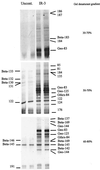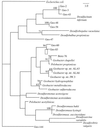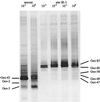Microbial communities associated with anaerobic benzene degradation in a petroleum-contaminated aquifer
- PMID: 10388703
- PMCID: PMC91456
- DOI: 10.1128/AEM.65.7.3056-3063.1999
Microbial communities associated with anaerobic benzene degradation in a petroleum-contaminated aquifer
Abstract
Microbial community composition associated with benzene oxidation under in situ Fe(III)-reducing conditions in a petroleum-contaminated aquifer located in Bemidji, Minn., was investigated. Community structure associated with benzene degradation was compared to sediment communities that did not anaerobically oxidize benzene which were obtained from two adjacent Fe(III)-reducing sites and from methanogenic and uncontaminated zones. Denaturing gradient gel electrophoresis of 16S rDNA sequences amplified with bacterial or Geobacteraceae-specific primers indicated significant differences in the composition of the microbial communities at the different sites. Most notable was a selective enrichment of microorganisms in the Geobacter cluster seen in the benzene-degrading sediments. This finding was in accordance with phospholipid fatty acid analysis and most-probable-number-PCR enumeration, which indicated that members of the family Geobacteraceae were more numerous in these sediments. A benzene-oxidizing Fe(III)-reducing enrichment culture was established from benzene-degrading sediments and contained an organism closely related to the uncultivated Geobacter spp. This genus contains the only known organisms that can oxidize aromatic compounds with the reduction of Fe(III). Sequences closely related to the Fe(III) reducer Geothrix fermentans and the aerobe Variovorax paradoxus were also amplified from the benzene-degrading enrichment and were present in the benzene-degrading sediments. However, neither G. fermentans nor V. paradoxus is known to oxidize aromatic compounds with the reduction of Fe(III), and there was no apparent enrichment of these organisms in the benzene-degrading sediments. These results suggest that Geobacter spp. play an important role in the anaerobic oxidation of benzene in the Bemidji aquifer and that molecular community analysis may be a powerful tool for predicting a site's capacity for anaerobic benzene degradation.
Figures







References
-
- Anderson R T, Lovley D R. Ecology and biogeochemistry of in situ groundwater bioremediation. Adv Microb Ecol. 1997;15:289–350.
-
- Anderson R T, Rooney-Varga J N, Gaw C V, Lovley D R. Anaerobic benzene oxidation in the Fe(III) reduction zone of petroleum-contaminated aquifers. Environ Sci Technol. 1998;32:1222–1229.
-
- Anderson, R. T., and D. R. Lovley. Naphthalene and benzene degradation under Fe(III)-reducing conditions in petroleum-contaminated aquifers. Bioremediation, in press.
Publication types
MeSH terms
Substances
Associated data
- Actions
- Actions
- Actions
- Actions
- Actions
- Actions
- Actions
- Actions
- Actions
- Actions
- Actions
- Actions
- Actions
- Actions
- Actions
- Actions
- Actions
- Actions
- Actions
- Actions
- Actions
- Actions
- Actions
- Actions
- Actions
- Actions
- Actions
- Actions
- Actions
- Actions
LinkOut - more resources
Full Text Sources
Other Literature Sources
Molecular Biology Databases
Miscellaneous

